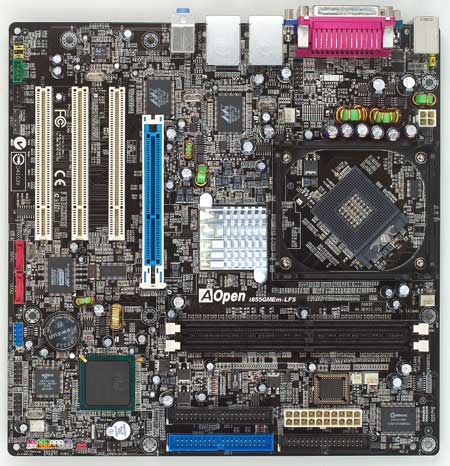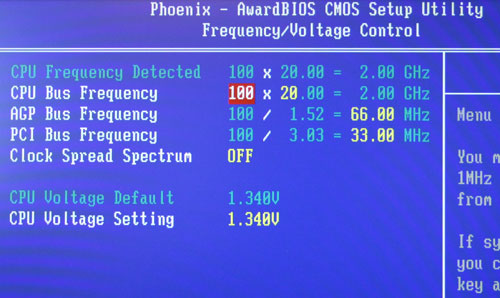Intel's Pentium M on the Desktop - A Viable Alternative?
by Anand Lal Shimpi on February 7, 2005 4:00 PM EST- Posted in
- CPUs
The Motherboards
As we mentioned before, both AOpen and DFI are currently shipping Pentium M desktop micro ATX motherboards based on Intel's 855GME chipset.AOpen
The AOpen GMEm-LFS is a micro ATX board based on the 855GME chipset, with integrated graphics support as provided by the chipset.
AOpen outfitted the board with dual GigE ports, both of which are placed on the back I/O panel above the four USB 2.0 ports.
The board only requires a 20-pin ATX power connector and a 4-pin +12V auxiliary connector like older Pentium 4 motherboards, although you can use a newer 24-pin PSU if you'd like.
Since AOpen uses ICH4-M, only parallel ATA is supported, so AOpen outfitted the board with a Promise SATA RAID controller to drive the two SATA ports on the board. AOpen also placed an Agere FireWire 400 controller on the board; however, they didn't supply the bracket to actually take advantage of the two ports supported by the controller.
The BIOS setup of the GMEm-LFS is pretty straightforward, although we definitely appreciated the layout of the overclocking options. The only complaint we had was that memory dividers weren't explicitly listed, which requires some math on the user's part to make sure that they're selecting the right memory speed when overclocking. The only voltage adjustments present on the board are for Vcore, which unfortunately tops out at 1.340V.

We had pretty decent overclocking success with the AOpen board and our Pentium M 755 (2.0GHz). Running it at 133MHz (533MHz FSB) x 18 at the maximum core voltage of 1.340V proved to be quite stable in all of our benchmarks. We could get the Pentium M to POST at 2.53GHz, but it wasn't stable enough to run our benchmarks.
Unfortunately, the biggest problem with overclocking the AOpen (as well as the DFI) board was that you could hardly overclock the memory bus. Regardless of what type of DDR400 memory we used, the highest that we could get the memory bus to run (stable) was 355MHz using the 4:3 memory divider.
Given how bandwidth-starved the Pentium M is, we were hoping for better overclocking success in the memory department, but were met with disappointment. The problem appears to be related to the 855GME chipset, as the DFI board suffered the same fate as the AOpen board.
So, while there's headroom in the CPUs (even our 1.7GHz Pentium Ms had no problems running above 2.0GHz), it seems like the chipsets/motherboards will limit the extent to which you can overclock.
The AOpen GMEm-LFS currently sells for $230.










77 Comments
View All Comments
CSMR - Monday, February 7, 2005 - link
The fact is it's an excellent processor for business use (speed, quietness, reliability) and multimedia use (quietness). Anandtech is full of gamers; but there is no denying that using a computer as a media centre is becoming a big thing, or that low-power, quiet operation is necessary. High motherboard prices are because the desktop PM motherboard market is very small. There was a comment in the review that the PM architecture doesn't scale well. I am sure that is so; but what processors do scale well? It's because they don't that everyone is about to go dual-core.bobsmith1492 - Monday, February 7, 2005 - link
Thanks #12 :PZebo - Monday, February 7, 2005 - link
I myself have been guilty of hyping dothan after seeing GAMEPCs "opimistic" review. This should quell that.:DZebo - Monday, February 7, 2005 - link
Anand best review I've read here, thanks a lot, nice to see you scribing again..:)Seems again, like the tech report review, with a comprehensive test suite such as this one dothan has some collosal performance flaws, and simply can't match up the A64 across board. It looses 30 out of 41 benches at same speed, some huge. 2.0 vs 2.0..
I posted in CPU forum how turion/lancaster will be 25W.. could this be the end of DOTHANS laptop dominace?
Brian23 - Monday, February 7, 2005 - link
I agree with #10.bobsmith1492 - Monday, February 7, 2005 - link
Sorry; first time commenting. I couldn't remember my login name before.Anyway, my laptop OCs better than that. Granted, it's a 1.7 to begin with, but the FSB will do 125 easily, with the same ram increase to boot - 420 MHz, with processor at 2.125. It will do a tad bit more, but that's enough for a laptop I'd say.
bobsmith1492 - Monday, February 7, 2005 - link
testKalessian - Monday, February 7, 2005 - link
#6, Oh yeah? Well, give a P4/A64 an SXGP(Super eXtremely Good Performance) setting and stay out of ITS way!Yawn, right now the P-M doesn't impress me at all. Let a CPU built for mobile systems stay in mobile systems until it gets rebuilt for desktops properly.
Great review, learned a ton :)
GnomeCop - Monday, February 7, 2005 - link
I have a 2.0ghz dothan system, I upgraded from an old 533mhz fsb p4.The speed for my work and games are just fine. I have a leadtek GF6800ultra in my system and its the only thing I have to worry about cooling.
CPU is passively cooled and the system is expremely quiet running on a 359watt psu. By the time I need to upgrade, I will be buying a whole new cpu/mobo/everything anyways.
ksherman - Monday, February 7, 2005 - link
seems like an a really good processor for buisness machines, given the L1 cahe speeds... and not much else (snas uber low power consumption)